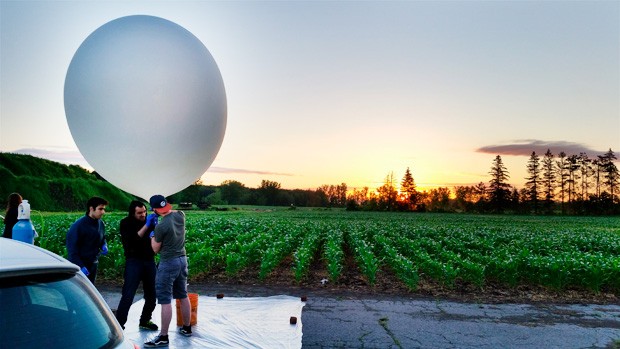Space Concordia is up, up and away!

A team of seven Concordia students took their Capstone project to the next level when they launched a high-altitude balloon into the atmosphere earlier this summer.
The balloon reached an area called near space — a height with very little air, but where what’s left generates too much drag for satellites to remain in orbit.
Capstone projects enable undergraduate engineering students to undertake a team design activity from scratch, gain project management experience, and practice their technical writing and presentation skills throughout the final year of their degree.
The team opted to design a high-altitude balloon due to the technically demanding nature of the project and the opportunity to enhance Space Concordia’s reach.
They also built the balloon to provide the Concordia community with an opportunity to send something into space — a scientific platform for anyone with an idea or lightweight experiment they would like to try.
“Our team wanted to build a low-cost, reusable and redundant gondola that could control its orientation and conduct experiments related to astronomy, earth remote sensing and photography, without the need of launching or contracting a satellite,” explains team member Emmanuel Papanagiotou.
Jan Clarence Dee (BEng 17) says he knew right off the bat that he wanted to work with Space Concordia on his Capstone. "We wanted to show professors and students of any age and background how cool space could be."
Team member Olivier Bemmann (BEng 17) says working on the project was especially interesting because it allowed him to immerse himself in space science.
“It isn't something we get to spend a lot of time on in the undergraduate engineering curriculum."
Made up of mechanical engineering students, the team required skills and expertise from outside their discipline — they had to find a way to design and build electrical and software subsystems for the balloon.
"I am extremely proud of how well everything turned out. Nothing failed," says Dee, who took on the non-mechanical components.
From theory to practice
The students also had to learn to apply knowledge from their field of study. Specifically, they worked to simulate and analyze the impact of static and dynamic forces on composite materials. They each took on learning different aspects not learned in class — most notably collaborative engineering.
“I personally loved the interdisciplinary character of the project,” describes Papanagiotou, “the project had a high degree of integration where many systems had to work together.”
"Our degree in mechanical engineering is comprehensive in its educational scope: we learn the theory, do our assignments and test our knowledge during the midterm and final exams. Capstone takes all this knowledge and transitions us from an academic environment to practical application," Bemmann explains.
The launch of the balloon, on June 24, was a culmination of all their efforts. Capstone projects require a gruelling amount of work with key deadlines that are tied to the project and team members' academic success.
"We were all extremely stressed and exhausted by the end," Dee says. “The launch was quite revitalizing and the perfect end to our term."
Hands-on learning ‘opens doors’
Choosing to work on the high-altitude balloon project has already paid off for Dee. He is currently working at the Canadian Space Agency on its stratospheric balloon project, where he is applying the skills he learned at Concordia.
Dee recently shared his experience with project-based learning and its importance in today’s very demanding market through a blog post on medium.com.
Bemmann says students gain a lot from joining societies like Space Concordia and becoming involved with hands-on projects while at university.
“It doesn’t matter which one,” he adds. “The more you learn now, the more experience you have, the more it opens doors to career opportunities when you graduate."
Have an experiment that you want to launch in Space Concordia's high-altitude balloon? Contact Zaid Rana, coordinator of Special Projects for the society.


